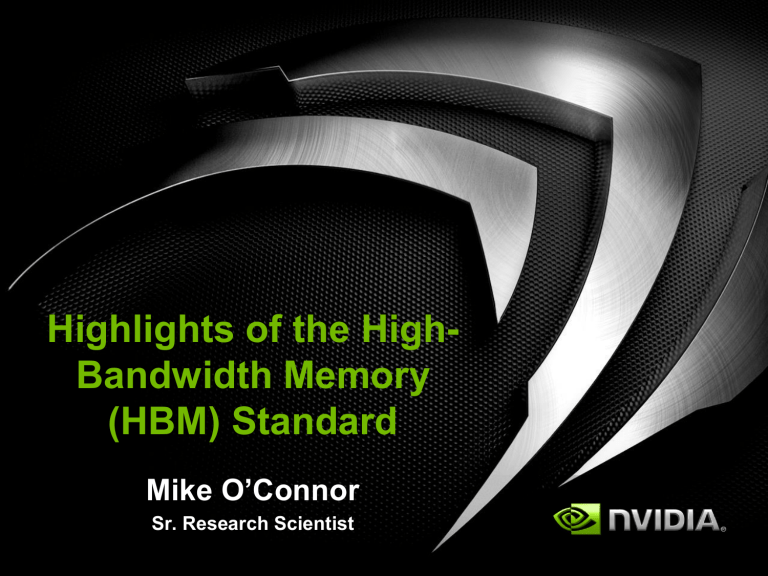High-Bandwidth Memory (HBM) Standard Highlights

Highlights of the High-
Bandwidth Memory
(HBM) Standard
Mike O’Connor
Sr. Research Scientist
What is High-Bandwidth Memory (HBM)?
Memory standard designed for needs of future GPU and HPC systems:
Exploit very large number of signals available with diestacking technologies for very high memory bandwidth
Reduce I/O energy costs
Enable higher fraction of peak bandwidth to be exploited by sophisticated memory controllers
Enable ECC/Resilience Features
JEDEC standard JESD235, adopted Oct 2013.
Initial work on standard started in 2010
The Memory Forum – June 14, 2014
What is High-Bandwidth Memory (HBM)?
Enables systems with extremely high bandwidth requirements like future high-performance GPUs
The Memory Forum – June 14, 2014
HBM Overview
Standard defines an HBM stack
Bonding footprint
Interface Signaling
Commands & Protocol
Some optional features:
ECC support
Base-layer logic/redistribution/IO die
Standard does not define
Internal architecture of the stack
Precise DRAM timing parameters
The Memory Forum – June 14, 2014
HBM Overview
Channel 0 Channel 1
4 DRAM dies with 2 channels per die
Each HBM stack provides 8 independent memory channels
These are completely independent memory interfaces
Independent clocks & timing
Independent commands
Independent memory arrays
In short, nothing one channel does affects another channel
The Memory Forum – June 14, 2014
Optional Base “Logic” Die
*Figure from JEDEC Standard
– High Bandwidth Memory (HBM) DRAM, JESD 235, Oct. 2013
HBM Overview - Bandwidth
Each channel provides a 128-bit data interface
Data rate of 1 to 2 Gbps per signal (500-1000 MHz DDR)
16-32 GB/sec of bandwidth per channel
8 Channels per stack
128-256 GB/sec of bandwidth per stack
For comparison:
Highest-end GPU today (NVIDIA GeForce GTX TITAN Black)
384b wide GDDR5 (12 x32 devices) @ 7 Gbps = 336 GB/s
Future possible GPU with 4 stacks of HBM
Four stacks of HBM @ 1-2 Gbps = 512 GB/s - 1 TB/s
– cost
The Memory Forum – June 14, 2014
HBM Overview - Bandwidth
Each channel provides a 128-bit data interface
Data rate of 1 to 2 Gbps per signal (500-1000 MHz DDR)
16-32 GB/sec of bandwidth per channel
For comparison:
~
6-7 pJ/bit vs.
384b wide GDDR5 (12 x32 devices) @ 7 Gbps = 336 GB/s
– cost
Future possible GPU with 4 stacks of HBM
Four stacks of HBM @ 1-2 Gbps = 512 GB/s - 1 TB/s
– power cost
The Memory Forum – June 14, 2014
HBM Overview - Capacity
Per-channel capacities supported from 1-32 Gbit
Stack capacity of 1 to 32GBytes
Near-term, at lower-end of range e.g. 4 high stack of 4Gb dies = 2GBytes/stack
8 or 16 banks per channel
16 banks when > 4Gbit per channel (> 4GBytes/stack)
Not including optional additional ECC bits
A stack providing ECC storage may have 12.5% more bits
The Memory Forum – June 14, 2014
HBM Channel Overview
Each channel is similar to a standard DDR interface
Data interface is bi-directional
Still requires delay to “turn the bus around” between RD and WR
Burst-length of 2 (32B per access)
Requires traditional command sequences
Activates required to open rows before read/write
Precharges required before another activate
Traditional dram timings still exist (tRC, tRRD, tRP, tFAW, etc.)
– but are entirely per-channel
The Memory Forum – June 14, 2014
HBM Channel Summary
Function
Data
# of µBumps Notes
128 DDR, bi-directional
Column Command/Addr. 8
Row Command/Addr. 6
DDR
DDR
Data Bus Inversion
Data Mask/Check Bits
Strobes
Clock
Clock Enable
Total
16
16
16
2
1
193
1 for every 8 Data bits, bi-directional
1 for every 8 Data bits, bi-directional
Differential RD & WR strobes for every 32 Data bits
Differential Clock
Enable low-power mode
The Memory Forum – June 14, 2014
New: Split Command Interfaces
2 semi-independent command interfaces per channel
“Column Commands” – Read / Write
“Row Commands” – ACT / PRE / etc.
Key reasons to provide separate row command i/f:
100% col. cmd bandwidth to saturate the data bus w/ BL=2
Simplifies memory controller
Better performance (issue ACT earlier or not delay RD/WR)
Still need to enforce usual ACT RD/WR PRE timings
The Memory Forum – June 14, 2014
New: Single-Bank Refresh
Current DRAMs require refresh operations
Refresh commands require all banks to be closed
~ 1 refresh command every few µsec
Can consume 5-10% of potential bandwidth
Increasing overheads with larger devices
Sophisticated DRAM controllers work hard to overlap
ACT/PRE in one bank with traffic to other banks
Can manage the refresh similarly
Added “Refresh Single Bank” command
Like an ACT, but w/ internal per-bank row counter
Can be issued to any banks in any order
Memory controller responsible for ensuring all banks get enough refreshes each refresh period
The Memory Forum – June 14, 2014
New: Single-Bank Refresh
Bank 0
Bank 1
Bank n
PRE
PRE
PRE
Refresh
(All Banks)
ACT RD
ACT
Traditional Precharge-All and Refresh-All
RD
ACT
Bank 0
Bank 1
Bank n
PRE
RD
ACT
PRE
RD
ACT
PRE
RD
REFSB
PRE ACT
ACT
PRE PRE REFSB ACT
Arbitrary Single-Bank Refresh
RD
The Memory Forum – June 14, 2014
New: RAS Support
HBM standard supports ECC
Optional: Not all stacks required to support it
ECC and non-ECC stacks use same interface
Key insight:
Per-byte data mask signals and ECC not simultaneously useful
Data Mask Signals can carry ECC data
- makes them bi-directional on HBM stacks that support ECC
Parity check of all cmd/addr busses also supported
The Memory Forum – June 14, 2014
Other HBM Features
HBM supports Temperature Compensated Self
Refresh
Temperature dependent refresh rates with several temperature ranges (e.g. cool/standby, normal, extended, emergency)
Temperature sensor can be read by memory controller to adjust its refresh rates as well
Data Bus Inversion coding to reduce number of simultaneously switching signals
No more than 4 of 9 (DQ[0..7], DBI) signals switch
DBI computation maintained across consecutive commands
The Memory Forum – June 14, 2014
Thank You
QUESTIONS? moconnor@nvidia.com
The Memory Forum – June 14, 2014
BACKUP
The Memory Forum – June 14, 2014
Footprint
BACKUP
The Memory Forum – June 14, 2014
HBM Footprint
The Memory Forum – June 14, 2014
*Figure from JEDEC Standard
– High Bandwidth Memory (HBM) DRAM, JESD 235, Oct. 2013
HBM Footprint
Half of
One channel
Data i/f
The Memory Forum – June 14, 2014
Four channels
Command i/f
*Figure from JEDEC Standard
– High Bandwidth Memory (HBM) DRAM, JESD 235, Oct. 2013
Commands
BACKUP
The Memory Forum – June 14, 2014
Column Commands
Command
Column NOP
Read
Write
Mode Register Set
Clock C[0:7]
Rising CNOP / XXXXX
Falling XXXXXXX / Parity
Rising RD / Autoprecharge / Bank
Falling Column Address / Parity
Rising RD / Autoprecharge / Bank
Falling Column Address / Parity
Rising MRS / Mode Reg
Falling Opcode
The Memory Forum – June 14, 2014
Row Commands
Command
Row NOP
Activate
Precharge
Precharge All Banks
Refresh (single bank)
Refresh (all banks)
Clock R[0:5]
Rising RNOP / XXX
Falling XXXXX / Parity
Rising ACT / Bank
Falling Row Address[15:11] / Parity
Rising Row Address[10:5]
Falling Row Address[4:0] / Parity
Rising PRE / Bank
Falling XXXXX / Parity
Rising PREA / XXX
Falling XXXXX / Parity
Rising REFSB / Bank
Falling XXXXX / Parity
Rising REF / XXX
Falling XXXXX / Parity
The Memory Forum – June 14, 2014
RAS
BACKUP
The Memory Forum – June 14, 2014
HBM RAS Challenges
Stacked Memory has some challenges with respect to
RAS requirements
Traditional DRAM DIMMs get only a subset of bits (e.g.
4) from each burst from a single DRAM device
HBM gives you all the bits of a burst from a single row of a single bank of a single DRAM device
Good for power, but RAS-wise all our eggs are in one basket
Including the ECC bits
Need techniques to detect failures (e.g. row decode fault)
Need techniques to recover from failures (e.g. RAID-like schemes)
The Memory Forum – June 14, 2014







